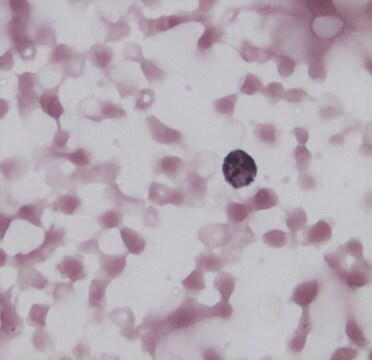2160
Autofluorescence Eliminator Reagent
Autofluorescence Eliminator Reagent for IHC.
Synonym(e):
fluorescence IHC counter stain
About This Item
Empfohlene Produkte
Form
liquid
Verpackung
pkg of 50 mL
Hersteller/Markenname
Chemicon®
Methode(n)
immunohistochemistry: suitable
Versandbedingung
ambient
Allgemeine Beschreibung
Anwendung
PROTOCOL:
1.After immunofluorescence histochemistry, the sections are immersed in PBS for 5 min.·
2.Sections are immersed in 70% ethanol for 5 min.·
3.Sections are immersed in Autofluorescence Eliminator Reagent for 5 min.
4.Sections are immersed in three changes of 70% ethanol for 1 min. each time.·
5.Sections are mounted using an antifading solution (e.g. DABCO, non-xylene-based).
Note: Reagent will block all fluorescence if incubation is too long; length of incubation time and number of 70% ethanol washes can be altered and optimized for various tissues and fluorescent antibody probes. In some instances the reagent can be applied prior to immunofluorescence, however in most cases better results are obtained when used as we direct above (use after immunofluorescence procedures are completed).
Optimal time of incubation with the Autofluorescence Eliminator Reagent should be determined by the end user for each sample.
Absorption maximum: 595-605
Physikalische Form
Lagerung und Haltbarkeit
Rechtliche Hinweise
Haftungsausschluss
Signalwort
Danger
H-Sätze
Gefahreneinstufungen
Eye Irrit. 2 - Flam. Liq. 2 - Muta. 2 - STOT SE 2
Zielorgane
Eyes,Central nervous system
Lagerklassenschlüssel
3 - Flammable liquids
WGK
WGK 2
Flammpunkt (°F)
60.8 - 68.0 °F
Flammpunkt (°C)
16 - 20 °C
Analysenzertifikate (COA)
Suchen Sie nach Analysenzertifikate (COA), indem Sie die Lot-/Chargennummer des Produkts eingeben. Lot- und Chargennummern sind auf dem Produktetikett hinter den Wörtern ‘Lot’ oder ‘Batch’ (Lot oder Charge) zu finden.
Besitzen Sie dieses Produkt bereits?
In der Dokumentenbibliothek finden Sie die Dokumentation zu den Produkten, die Sie kürzlich erworben haben.
Kunden haben sich ebenfalls angesehen
Unser Team von Wissenschaftlern verfügt über Erfahrung in allen Forschungsbereichen einschließlich Life Science, Materialwissenschaften, chemischer Synthese, Chromatographie, Analytik und vielen mehr..
Setzen Sie sich mit dem technischen Dienst in Verbindung.











